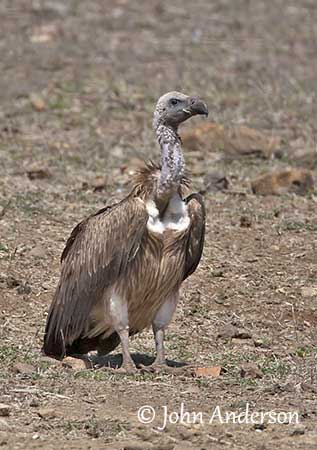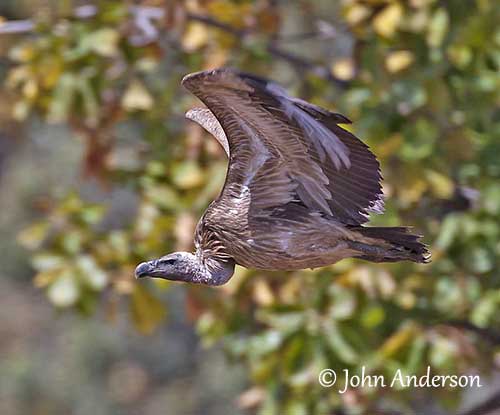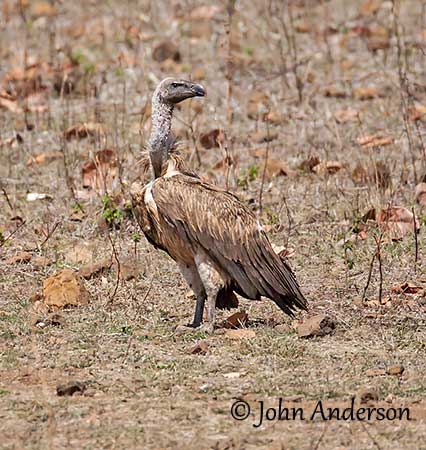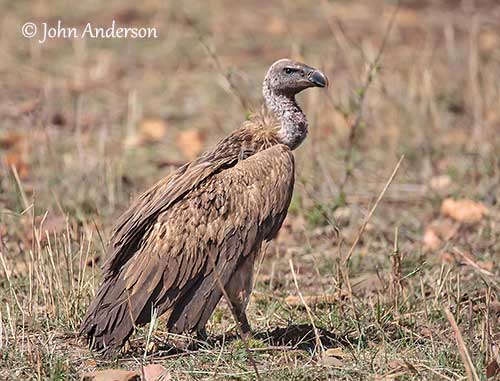
Fr : Vautour à long bec - Vautour à bec élancé
Ang : Slender-billed Vulture
All : Dünnschnabelgeier
Esp : Buitre picofino
Ita : Avvoltoio beccosottile
Nd: Dunsnavelgier
Sd: smalnäbbad gam
Photographer:
John Anderson
John Anderson Photo Galleries
Text by Nicole Bouglouan
Sources :
HANDBOOK OF THE BIRDS OF THE WORLD Vol 2 by Josep del Hoyo-Andrew Elliot-Jordi Sargatal - Lynx Edicions - ISBN: 8487334156
A Field Guide to the Birds of South-East Asia by Craig Robson. New Holland Publishers. ISBN: 9781780090498
Global Raptor Information Network - Working to Conserve Birds of Prey in nature
Wikipedia, the free encyclopaedia
India Netzone - Slender-Billed Vulture, Indian Bird
Habitat loss of critically endangered vultures in Nameri National Park-Assam
Canisius Ambassadors for Conservation
Indianbirds - Slender-billed Vulture
Slender-billed Vulture
Gyps tenuirostris
Accipitriformes Order – Accipitridae Family
INTRODUCTION:
The Slender-billed Vulture was formerly a subspecies of the Indian Vulture (Gyps indicus), but it is now a full species. It differs from G. indicus by several morphological features. This species is found in India, Nepal, Myanmar, Laos and Cambodia.
Like other Old World Vultures, it is a scavenger and feeds primarily on dead animals. It frequents wooded areas and dry open country away from human settlements. It is sedentary in its range and moves only for food.
The Slender-billed Vulture has suffered heavy decline in mid-2000, due to drug Diclofenac present in carcasses of dead domestic livestock. More recently, a second drug, the Ketoprofen, has been identified to be toxic to Gyps species. This drug is found in ungulates carcasses in India, and may cause mortalities too.
The Slender-billed Vulture has small population suspected to be still decreasing. It is currently listed as Critically Endangered.

DESCRIPTION OF THE BIRD:
Biometrics:
Length: 80-100 cm
Wingspan: 190-260 cm
Weight: 4 -7 kg
The Slender-billed Vulture adult has rather pale sandy-brown body and wing-coverts, contrasting with the naked blackish head and fairly long neck, both with sparse whitish down. The neck ruff is relatively small and short. Lower back and rump are whitish. The greater coverts have dark centres both on upper and underwings. The flight feathers are very dark.
The buffy underparts contrast with the blackish flight feathers, whereas the underwing-coverts are very pale.
Head and neck are blackish, with narrow head profile and rather angular crown. The ear opening is prominent and exposed. The bare skin is thickly creased and wrinkled.
The bill is dark with pale culmen and blackish cere. It is relatively long and slender, giving the bird its name. The eyes are dark brown. Legs and feet are dark grey.
Male and female are similar.
The juvenile resembles adult, but it has browner neck-ruff. The upperwing-coverts are duller and browner with indistinct streaks. Underparts and underwing-coverts are duller and browner. The bird becomes gradually paler with age.
RANGE:
The Slender-billed Vulture is found in lower Himalayas from NW India (Haryana) through Nepal to Assam, and N and E Myanmar, also Cambodia and S Laos, Malaysia, Pakistan and Thailand.

REPRODUCTION OF THIS SPECIES:
The breeding season occurs between October and March. The Slender-billed Vulture may be loosely colonial (up to 10 pairs), but it is more often solitary nester. Both adults build a large, bulky stick nest with shallow cup. It is placed in large tree, between 7 and 15 metres above the ground, or on rock ledge or building.
The female lays a single white egg with some pale reddish flecks and blotches. The incubation lasts about 50 days, shared by both parents.
The chick is regularly fed by the adults at nest, and for some weeks more after fledging.
PROTECTION / THREATS / STATUS:
The Slender-billed Vulture suffered large declines by mid-2000, due to ingestion of drug Diclofenac while feeding at carcasses of domestic livestock. A second drug, the Ketoprofen, has also been identified to be toxic to the vultures. This drug is present in ungulate carcasses in India, causing population decline. In addition, persecution in Laos and poisoning are also a problem.
The vultures are threatened by lack of food in Cambodia, with very low population densities of wild ungulates. In private lands, the nesting trees are destroyed for timber in Nepal.
The population is estimated to number 1,500/3,750 individuals. However, program of captive breeding to conserve the species is in progress, in order to release vultures in the wild, in protected and suitable areas.
The Slender-billed Vulture is currently listed ad Critically Endangered.

HABITAT:
The Slender-billed Vulture frequents open country and partly wooded areas in lowlands, and sometimes slopes up to 1500 metres of elevation.
It can be seen feeding at carcasses near villages and around slaughterhouses and rubbish dumps.
CALLS AND SONGS: SOUNDS BY XENO-CANTO
The Slender-billed Vulture produces occasional hissing and cackling sounds. While feeding at carcasses, some grunting sounds are often heard.
BEHAVIOUR IN THE WILD:
The Slender-billed Vulture is a scavenger. It feeds mostly from carcasses of various dead animals such as cattle, wild ungulates and human corpses in India. It often feeds at rubbish dumps and near slaughterhouses where it can get debris.
They usually feed in groups with other vultures, including the White-rumped Vulture (Gyps bengalensis) and the Red-headed Vulture (Sarcogyps calvus). It gorges itself and then, it rests to digest the food.
There is little information about the breeding behaviour of this vulture. It nests in large, bulky stick nest in large tree or on rocky ledge. Both adults share all the nesting duties.
Aerial displays with flight in tandem are probably performed above the nesting-site.
The Slender-billed Vulture is sedentary in its range, but it is subject to local movements related to food resources.
Like other large vultures, it spends most of the time soaring on spread wings, using the thermal currents along the cliffs that help the bird to rise into the air. It rarely flaps the wings, except at take-off.
